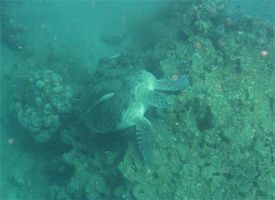Green Turtle Beauty Parlour!
Have you ever seen turtles with parallel scratches running almost the full length of the carapace? Well, that was a freshly cleaned turtle! Yes, turtles do need to clean their carapace from all the algae, limpets, barnacles and other animals that can fix on it. Cleaning is such an important issue that green turtles swim deliberately to specific sites to get their carapace cleaned. These places, known as cleaning stations are usually mushroom-shaped rocky structures: on top of the mushroom the turtle is cleaned by different species of herbivorous fish (e.g. surgeon and damsel fish), while under the mushroom the turtle can vigorously rub its carapace against the rock to get rid of barnacles and limpets. During field surveys, the HEPCA Turtle team identified at least four different cleaning stations in the Southern Egyptian Red Sea (and we are sure that there are more out there!). Finally in July the team managed to film this behavior at a cleaning station in Ras Baghdadi in the Wadi Gimal National park. Check the video on http://youtu.be/3ljhbsyo86s. In the video a female green turtle is seen swimming straight towards the cleaning station with 2-3 yellow-tail surgeonfish following her. Once on top of the site, she assumes the “ready-to-be-cleaned” position: motionless, flippers and head extended and dropped downward. The surgeonfish inspect the turtle first and then nip specific parts of the turtle skin (neck and front-flippers). When the surgeonfish are done, the turtle leaves as well. This is a win-win situation: the turtle is free from algae and parasites while the surgeonfish have food without having to chase it! The cleaning station was not very busy that day, only two turtles were recorded in approximately two hours. However, during winter months we have seen aggregations of up to eight individuals, some rubbing their carapaces, one on top getting cleaned and one or two turtles hovering by the top followed by “cleaners”, so we plan to go back during winter months and get more video footage to document this behaviour. We are extremely grateful to Kerstin and Essam from Wadi Gimal Diving Center for their support in the field. We would also like to thank Ahmed Sonbol for joining the HEPCA Red Sea Turtle Project and helping us with the data collection.



